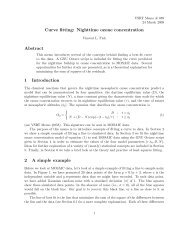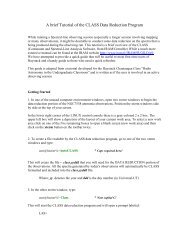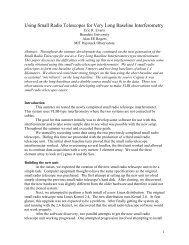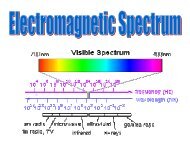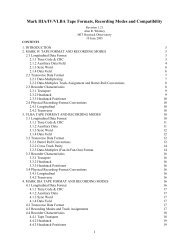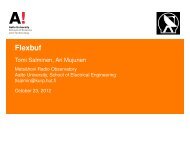Haystack Small Radio Telescope - MIT Haystack Observatory
Haystack Small Radio Telescope - MIT Haystack Observatory
Haystack Small Radio Telescope - MIT Haystack Observatory
You also want an ePaper? Increase the reach of your titles
YUMPU automatically turns print PDFs into web optimized ePapers that Google loves.
Mounting the Dish<br />
The dish can either be mounted on the roof of a building or somewhere outside. It is best<br />
to have as few obstructions to the sky as possible, though having a nearby tree act as an absorber<br />
for calibration may be useful. It is also desirable to have the telescope as far away from a<br />
building as possible to reduce interference from computers and other electronics.<br />
Two different mounting methods are recommended: a concrete pier or a non-penetrating<br />
roof mount. The concrete pier is permanent and requires a sufficient depth of soil to pour the<br />
mount. The non-penetrating mount can either be used on a flat roof or on flat ground, and can be<br />
disassembled and moved with relative ease.<br />
Concrete Pier<br />
This section is adapted from the original SRT manual.<br />
Remember that this is a permanent installation and moving the telescope requires a new<br />
pier to be built. Also note that soil mechanics can vary widely depending on the geographical<br />
location of the installation site. For this reason, it is recommended that you consult local building<br />
codes for information on how to properly install the pillar mount.<br />
� The pier foundation requires a round hole 30 inches in diameter and 4 feet deep. For<br />
areas that experience severe weather, be sure to dig the hole below the frost line.<br />
� Angle the sides of the hole outward so that it tapers towards the bottom. This will prevent<br />
the pillar from shifting during severe weather.<br />
� To improve drainage, fill the bottom of the hole with several inches of loose gravel.<br />
� The Spid rotor is designed to fit onto a 2.375” OD pipe. For the pier, use a section of 2”<br />
schedule 40 pipe 8 feet long (this has an outer diameter of 2.375”).<br />
� Place the pipe in the center of the hole and fill the hole with concrete (roughly 2/3 cubic<br />
yard), keeping the pipe level. This large a quantity of concrete should be prepared in a<br />
mixer or purchased from a concrete company.<br />
� Once the concrete is in, carefully level the pipe by placing a level against it, parallel to<br />
the pipe’s axis, and moving the pipe until the level reads vertical. Check this multiple<br />
times at two points 90° apart.<br />
� Once the pipe is level, use several boards to keep it from shifting while the concrete<br />
cures.<br />
3











